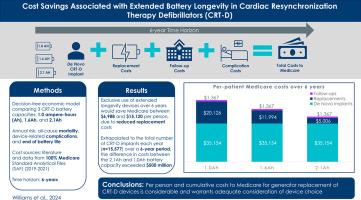Cost savings associated with extended battery longevity in cardiac resynchronization therapy defibrillators
IF 2.5
Q2 CARDIAC & CARDIOVASCULAR SYSTEMS
引用次数: 0
Abstract
Background
Cardiac resynchronization therapy-defibrillators (CRT-D) are devices established as treatment for symptomatic heart failure patients at risk of sudden cardiac death. Battery depletion poses a significant clinical and economic burden; extended service life may reduce costs because of generator changes and associated complications.
Objective
This study estimated cost-savings associated with extended battery longevity in Medicare patients receiving CRT-D implantation.
Methods
A decision tree was used to explore 3 battery capacities: 1.0 ampere-hours (Ah), 1.6Ah, and 2.1Ah. Yearly risk of all-cause mortality, device-related complications, and end of battery life were estimated. Over 6 years, estimated costs included device implantation, replacement, follow-up appointments, and complications.
Results
The average total costs to Medicare over 6 years were $41,527, $48,515, and $56,647 per person (USD 2023) for the 2.1 Ah, 1.6 Ah, and 1.0 Ah, respectively. The total per-person replacement cost for the 1.0-Ah devices was more than 4 times that of the 2.1-Ah devices ($20,126 vs $5,006). When extrapolated to the total number of CRT-D implants over a 6-year period, the difference in costs between 2.1-Ah and 1.0-Ah battery capacity exceeded $500 million.
Conclusion
Extended longevity CRT-D batteries demonstrate significant cost savings to Medicare over 6 years. These data indicate long-term economic considerations should be included in device selection.

延长心脏再同步治疗除颤器的电池寿命可节约成本
背景心脏再同步治疗-除颤器(CRT-D)是用于治疗有心脏性猝死风险的无症状心衰患者的设备。电池耗尽会造成严重的临床和经济负担;延长使用寿命可降低因更换发生器和相关并发症而产生的成本。本研究估算了接受 CRT-D 植入术的医保患者因延长电池寿命而节省的成本:方法使用决策树探索 3 种电池容量:1.0 安培小时 (Ah)、1.6 安培小时和 2.1 安培小时。估算了每年全因死亡率、设备相关并发症和电池寿命终止的风险。结果2.1Ah、1.6Ah和1.0Ah的医疗保险在6年内的平均总费用分别为每人41,527美元、48,515美元和56,647美元(2023年美元)。1.0 Ah 设备的人均更换总成本是 2.1 Ah 设备的 4 倍多(20126 美元对 5006 美元)。如果按 6 年内植入 CRT-D 的总数量推算,2.1-Ah 和 1.0-Ah 电池容量之间的成本差异超过 5 亿美元。这些数据表明,在选择设备时应考虑长期经济因素。
本文章由计算机程序翻译,如有差异,请以英文原文为准。
求助全文
约1分钟内获得全文
求助全文
来源期刊

Heart Rhythm O2
Cardiology and Cardiovascular Medicine
CiteScore
3.30
自引率
0.00%
发文量
0
审稿时长
52 days
 求助内容:
求助内容: 应助结果提醒方式:
应助结果提醒方式:


